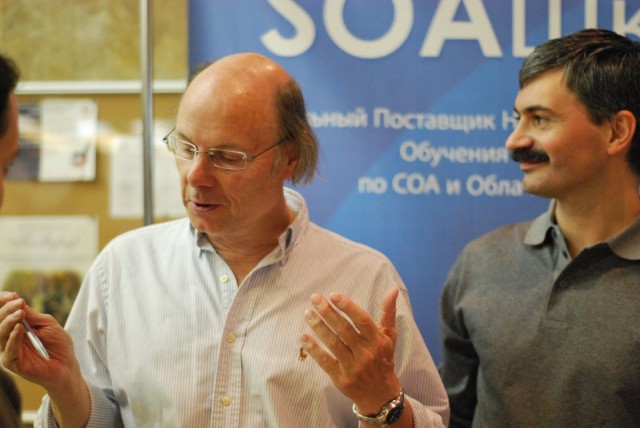The aim of this task is to provide a function to find the closest two points among a set of given points in two dimensions, i.e. to solve the Closest pair of points problem in the planar case.
The straightforward solution is a O(n2) algorithm (which we can call brute-force algorithm); the pseudocode (using indexes) could be simply:
bruteForceClosestPair of P(1), P(2), ... P(N)
if N < 2 then
return ∞
else
minDistance ← |P(1) - P(2)|
minPoints ← { P(1), P(2) }
foreach i ∈ [1, N-1]
foreach j ∈ [i+1, N]
if |P(i) - P(j)| < minDistance then
minDistance ← |P(i) - P(j)|
minPoints ← { P(i), P(j) }
endif
endfor
endfor
return minDistance, minPoints
endif
A better algorithm is based on the recursive divide&conquer approach, as explained also at Wikipedia, which is O(n log n); a pseudocode could be:
closestPair of (xP, yP)
where xP is P(1) .. P(N) sorted by x coordinate, and
yP is P(1) .. P(N) sorted by y coordinate (ascending order)
if N ≤ 3 then
return closest points of xP using brute-force algorithm
else
xL ← points of xP from 1 to ⌈N/2⌉
xR ← points of xP from ⌈N/2⌉+1 to N
xm ← xP(⌈N/2⌉)x
yL ← { p ∈ yP : px ≤ xm }
yR ← { p ∈ yP : px > xm }
(dL, pairL) ← closestPair of (xL, yL)
(dR, pairR) ← closestPair of (xR, yR)
(dmin, pairMin) ← (dR, pairR)
if dL < dR then
(dmin, pairMin) ← (dL, pairL)
endif
yS ← { p ∈ yP : |xm - px| < dmin }
nS ← number of points in yS
(closest, closestPair) ← (dmin, pairMin)
for i from 1 to nS - 1
k ← i + 1
while k ≤ nS and yS(k)y - yS(i)y < dmin
if |yS(k) - yS(i)| < closest then
(closest, closestPair) ← (|yS(k) - yS(i)|, {yS(k), yS(i)})
endif
k ← k + 1
endwhile
endfor
return closest, closestPair
endif
/* Author: Kevin Bacon Date: 04/03/2014 Task: Closest-pair problem */ #include <iostream> #include <vector> #include <utility> #include <cmath> #include <random> #include <chrono> #include <algorithm> #include <iterator> typedef std::pair<double, double> point_t; typedef std::pair<point_t, point_t> points_t; double distance_between(const point_t& a, const point_t& b) { return std::sqrt(std::pow(b.first - a.first, 2) + std::pow(b.second - a.second, 2)); } std::pair<double, points_t> find_closest_brute(const std::vector<point_t>& points) { if (points.size() < 2) { return { -1, { { 0, 0 }, { 0, 0 } } }; } auto minDistance = std::abs(distance_between(points.at(0), points.at(1))); points_t minPoints = { points.at(0), points.at(1) }; for (auto i = std::begin(points); i != (std::end(points) - 1); ++i) { for (auto j = i + 1; j < std::end(points); ++j) { auto newDistance = std::abs(distance_between(*i, *j)); if (newDistance < minDistance) { minDistance = newDistance; minPoints.first = *i; minPoints.second = *j; } } } return { minDistance, minPoints }; } std::pair<double, points_t> find_closest_optimized(const std::vector<point_t>& xP, const std::vector<point_t>& yP) { if (xP.size() <= 3) { return find_closest_brute(xP); } auto N = xP.size(); auto xL = std::vector<point_t>(); auto xR = std::vector<point_t>(); std::copy(std::begin(xP), std::begin(xP) + (N / 2), std::back_inserter(xL)); std::copy(std::begin(xP) + (N / 2), std::end(xP), std::back_inserter(xR)); auto xM = xP.at(N / 2).first; auto yL = std::vector<point_t>(); auto yR = std::vector<point_t>(); std::copy_if(std::begin(yP), std::end(yP), std::back_inserter(yL), [&xM](const point_t& p) { return p.first <= xM; }); std::copy_if(std::begin(yP), std::end(yP), std::back_inserter(yR), [&xM](const point_t& p) { return p.first > xM; }); auto p1 = find_closest_optimized(xL, yL); auto p2 = find_closest_optimized(xR, yR); auto minPair = (p1.first <= p2.first) ? p1 : p2; auto yS = std::vector<point_t>(); std::copy_if(std::begin(yP), std::end(yP), std::back_inserter(yS), [&minPair, &xM](const point_t& p) { return std::abs(xM - p.first) < minPair.first; }); auto result = minPair; for (auto i = std::begin(yS); i != (std::end(yS) - 1); ++i) { for (auto k = i + 1; k != std::end(yS) && ((k->second - i->second) < minPair.first); ++k) { auto newDistance = std::abs(distance_between(*k, *i)); if (newDistance < result.first) { result = { newDistance, { *k, *i } }; } } } return result; } void print_point(const point_t& point) { std::cout << "(" << point.first << ", " << point.second << ")"; } int main(int argc, char * argv[]) { std::default_random_engine re(std::chrono::system_clock::to_time_t( std::chrono::system_clock::now())); std::uniform_real_distribution<double> urd(-500.0, 500.0); std::vector<point_t> points(100); std::generate(std::begin(points), std::end(points), [&urd, &re]() { return point_t { 1000 + urd(re), 1000 + urd(re) }; }); auto answer = find_closest_brute(points); std::sort(std::begin(points), std::end(points), [](const point_t& a, const point_t& b) { return a.first < b.first; }); auto xP = points; std::sort(std::begin(points), std::end(points), [](const point_t& a, const point_t& b) { return a.second < b.second; }); auto yP = points; std::cout << "Min distance (brute): " << answer.first << " "; print_point(answer.second.first); std::cout << ", "; print_point(answer.second.second); answer = find_closest_optimized(xP, yP); std::cout << "\nMin distance (optimized): " << answer.first << " "; print_point(answer.second.first); std::cout << ", "; print_point(answer.second.second); return 0; }
- Output:
Min distance (brute): 6.95886 (932.735, 1002.7), (939.216, 1000.17) Min distance (optimized): 6.95886 (932.735, 1002.7), (939.216, 1000.17)
Content is available under GNU Free Documentation License 1.2.

































